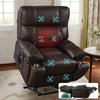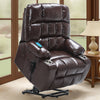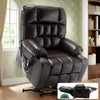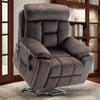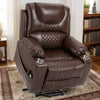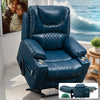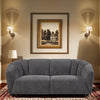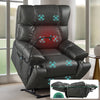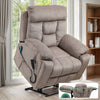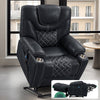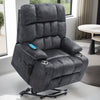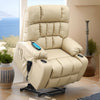Understanding the Needs of the Elderly
The Importance of Comfort and Ease of Movement
As our loved ones age, their comfort and mobility become top priorities. Seniors often face challenges with

everyday tasks. Simple actions like sitting down or standing up can be difficult. This is where mobility aids
come in handy. They provide support and ease of movement for the elderly.
Comfort is crucial for seniors' well-being. It affects their physical and mental health. Comfortable seating
can reduce pain and improve posture. It also promotes better circulation. Easy movement allows seniors to
stay active and independent. This boosts their confidence and quality of life.
When choosing between lift chairs and wheelchairs, comfort is key. Both options should offer proper support.
They should also be easy to use. The right choice depends on the individual's needs and lifestyle.
Evaluating the Elderly's Mobility and Personal Preferences
Assessing an elderly person's mobility is vital. It helps determine the best mobility aid for them. Some
seniors may have limited movement but can still walk short distances. Others might need full-time mobility
support. A thorough evaluation by a healthcare professional is recommended.
- Consider these factors:
- Level of independence
- Home environment
- Daily activities
- Physical limitations
- Personal preferences
Personal preferences matter too. Some seniors may prefer the comfort of a lift chair at home. Others might
value the freedom a wheelchair provides outdoors. It's important to involve the elderly in the decision-making
process. Their input ensures they'll be happy with the chosen mobility aid.
Lift Chairs vs. Wheelchairs: Features and Benefits
Lift Chairs: Convenience and Efficiency in Mobility
Lift chairs are specialized recliners designed for the elderly. They offer both comfort and mobility

assistance. These chairs use a powered lifting mechanism. This helps seniors stand up or sit down with ease.
Key features of lift chairs include:
- Adjustable positions for sitting, reclining, and sleeping
- Remote-controlled operation
- Built-in massage and heat functions (in some models)
- Various sizes to fit different body types
- Durable upholstery for easy cleaning
Lift chairs are ideal for seniors who spend a lot of time at home. They provide a comfortable spot to relax,
watch TV, or read. The lifting feature reduces strain on joints and muscles. This makes it easier for seniors
to get in and out of the chair.
However, lift chairs are not portable. They're designed for use in a fixed location at home. This limits
their use to indoor settings.
Wheelchairs: Versatility and Accessibility in Various Settings
Wheelchairs offer mobility solutions for seniors with limited walking ability. They come in various types,
from manual to electric. Wheelchairs provide freedom of movement both indoors and outdoors.
Benefits of wheelchairs include:
- Portability and easy transport
- Ability to navigate different terrains
- Customizable features for comfort and support
- Option for self-propelled or caregiver-assisted movement
- Accessories like oxygen tank holders or tray tables
Wheelchairs are versatile. They allow seniors to move around their homes, visit friends, or go shopping.
Electric wheelchairs offer more independence for those with limited upper body strength.
The downside is that wheelchairs require more space to maneuver. They may also need home modifications like
ramps or wider doorways.
Making the Right Choice for Elderly Care in the United States
Assessing the Costs: Lift Chairs vs. Wheelchairs
Cost is a major factor when choosing between lift chairs and wheelchairs. In the US, prices can vary widely

based on features and quality.
Lift chairs typically range from $600 to $2000 or more. Basic models are more affordable. High-end chairs
with advanced features cost more. Some insurance plans may cover part of the cost if prescribed by a doctor.
Wheelchair prices also vary. Manual wheelchairs can cost $100 to $500. Electric wheelchairs are pricier,
ranging from $1000 to $15000. Medicare often covers a portion of wheelchair costs if medically necessary.
Consider long-term costs too. Lift chairs may need less maintenance. Wheelchairs might require periodic
servicing or battery replacements.
Consulting With Healthcare Providers and Elderly Care Experts
Making an informed decision involves consulting experts. Healthcare providers can assess the senior's medical
needs. They can recommend the most suitable mobility aid.
Occupational therapists are valuable resources. They can evaluate how well a lift chair or wheelchair fits
into the senior's daily life. They might suggest trying both options to see which works best.
Elderly care experts can offer insights on long-term use. They understand how mobility needs might change
over time. Their advice can help you choose a solution that adapts to future needs.
Don't hesitate to seek multiple opinions. Each expert may offer unique perspectives. This helps in making a
well-rounded decision.
The Future of Elderly Mobility Solutions: Trends and Innovations
The field of elderly mobility aids is constantly evolving. New technologies are making mobility solutions
more effective and user-friendly.
Recent trends include:
- Smart lift chairs with voice control and fall detection
- Lightweight, foldable wheelchairs for easy transport
- Power-assist devices for manual wheelchairs
- Exoskeletons to help with walking and standing
These innovations aim to enhance independence and safety for seniors. They also make caregiving easier for
family members.
As technology advances, we can expect more personalized mobility solutions. Future aids might adapt to
individual needs in real-time. They could offer better integration with smart home systems.
When choosing between lift chairs and wheelchairs, consider future upgrades. Look for options that can
incorporate new technologies as they become available.








